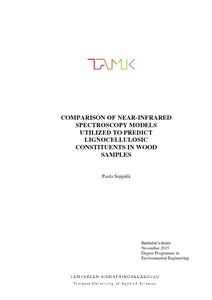Comparison of near-infrared spectroscopy models utilized to predict lignocellulosic constituents in wood samples
Seppälä, Paula (2015)
Julkaisun pysyvä osoite on
https://urn.fi/URN:NBN:fi:amk-2015120419444
https://urn.fi/URN:NBN:fi:amk-2015120419444
Tiivistelmä
To have alternatives for the petroleum-based fuels and chemicals, biomass as a resource shows promising results. There are various ways of converting this abundant feedstock to value-added products by biorefinering, but in order to enable the evaluation of process economics and conversion yields, accurate compositional analysis of the feedstock is required. The standard compositional laboratory analysis are often time consuming, laborious and feedstock constructive. The need for faster biomass analyzing techniques could be met by using near-infrared spectroscopy and mathematical techniques to create predictive models.
This study was made for an Irish company, Celignis Ltd, with the help and knowledge of the CEO, Daniel Hayes. The aim of this work was to evaluate the accuracy of predicted lignocellulosic constituents in wood samples by near-infrared spectroscopy models, the main objective being the comparison of models based solely on wood samples and models based on wider variety of also other biomass feedstocks. These models were referred to as local and global, respectively. Concentrations of four constituents; glucose, Klason lignin, xylose and mannose were analyzed and the capability of the models to predict these constituents in external wood sample set analyzed.
The results showed that both of the models were able to predict these components with reasonable accuracy. However, the wood-specific local models did not have increased predictive accuracies for glucose, xylose and mannose compared to the already existing global Celignis models. Even though good improvement was noted for the Klason lignin in the local model, based on these full results it is not justified to move from global to a local-model system.
This study was made for an Irish company, Celignis Ltd, with the help and knowledge of the CEO, Daniel Hayes. The aim of this work was to evaluate the accuracy of predicted lignocellulosic constituents in wood samples by near-infrared spectroscopy models, the main objective being the comparison of models based solely on wood samples and models based on wider variety of also other biomass feedstocks. These models were referred to as local and global, respectively. Concentrations of four constituents; glucose, Klason lignin, xylose and mannose were analyzed and the capability of the models to predict these constituents in external wood sample set analyzed.
The results showed that both of the models were able to predict these components with reasonable accuracy. However, the wood-specific local models did not have increased predictive accuracies for glucose, xylose and mannose compared to the already existing global Celignis models. Even though good improvement was noted for the Klason lignin in the local model, based on these full results it is not justified to move from global to a local-model system.

